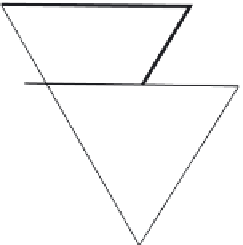Environmental Engineering Reference
In-Depth Information
content of soils and sediments, often called
humus
, is a
product of the microbially mediated biodegradation
process. It is rich in nutrients and remains for long
periods as an important supply for microorganisms.
A significant part of the soil organic matter is not bio-
degradable, and almost all of the organic matter is con-
tained in the O and A horizons of the soil profile. The
organic matter in the soil plays an important role in
retaining other pollutants and making them immobile.
It has a high storage capacity for metals and organic
chemicals, and it is concentrated at the interface between
the soil and the atmosphere, as well as between the soil
and plants.
Since particulate pollutant transport is part of the
sediment erosion and movement processes, many
models use an arbitrary proportionality factor called the
potency factor
or
transmission coefficient
to relate the
sediment loading to that of other contaminants. This
relationship is given by
100
90
10
80
20
Clay
Clay
(c)
(very fine)
70
30
60
40
Clay
(c) (fine)
50
50
Silty
clay (sic)
Sandy
clay (sic)
40
60
Clay loam
(cl)
Silty clay
loam (sicl)
Sandy
clay
loam (sci)
30
70
Loam
(I)
20
80
Sandy
loam (sl)
10
Silt loam
(sil)
(ls)
90
Loamy
sand
(s)
Sand
Silt (si)
100
100
90
80
70
60
50
40
30
20
10
Percent sand
Figure 6.21.
Soil texture triangle.
Y pY
i
=
(6.32)
i
s
where
Y
i
is the loading or concentration of contaminant
i
(MT
−1
),
p
i
is the potency factor for the contaminant
(dimensionless), and
Y
s
is the loading or concentration
of sediment from the soil (MT
−1
). Potency factors can
be related to the concentration of the contaminant in
the parent topsoil and the enrichment ratio for the
contaminant according to the relation
TABLE 6.13. USDA Slope
Classifications
Class
Slope Groupings (%)
A or no slope
class
0-3, 0-5
B
0-8, 3-8
C
8-15, 8-20, 8-25
D
15-25, 15-30
p
=
S
⋅ ER
(6.33)
E
25-70
i
si
i
F
45-65
where
S
si
is the concentration of the contaminant in the
topsoil (MM
−1
), and ER
i
is the enrichment ratio of the
contaminant between the source and the point of inter-
est or watershed outlet (dimensionless). The enrichment
ratio is the concentration of contaminant in the eroded
material divided by its concentration in the parent soil
material. Enrichment ratios, which are sometimes called
enrichment factors, depend on the soil and contaminant
of interest and are typically in the range of 1.0-4.0.
Enrichment ratios are generally greater than 1 because
it is mostly the finer soil fraction that is eroded, and this
finer soil fraction has a greater sorption capacity per
unit mass than the bulk soil.
Many regions have contaminated soils and leachable
residues caused by intensive agricultural practices.
Examples include phosphate-saturated soils, nitrate
leaching, and leaching of certain organic pesticides such
as atrazine and other chemicals. Certain agricultural
practices may increase or decrease the mobility of some
pollutants. For example, farming practices that increase
the ph levels in soils decrease the mobility of metals.
Also, the higher organic content of farmed soils increases
the retention of some organic chemicals, keeps them in
an oxidized state, and maintains an aerobic environ-
ment, which may be more favorable for biodegradation.
Organic matter is an integral part of soils and sedi-
ments. The organic content of soils varies from less than
1% to more than 40% in some organic soils, feedlot
soils, wetlands, and aquatic sediments. The organic
content of soils is usually reported as percent organic
matter or percent organic carbon. Soils that are aerated
usually have smaller organic content than soils that are
saturated with water most of the time. The organic
EXAMPLE 6.5
hillsdale Lake in eastern Kansas is surrounded by a
369-km
2
watershed in which the topsoil has an average
phosphorus concentration of 0.71 g of phosphorus per
kilogram of soil. Measurements in 2002 indicated an
annual sediment load into the lake of 21.9 × 10
6
kg
and a typical enrichment ratio of 2.4 for phosphorus.










































Search WWH ::

Custom Search